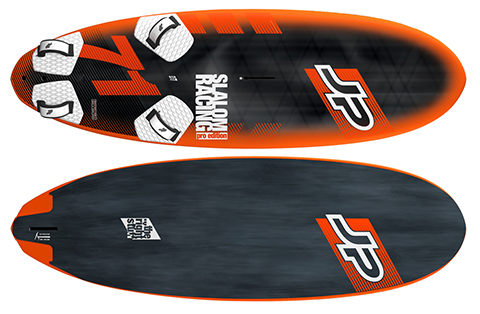
JP SLALOM PRO 71 2018 TEST REVIEW
JP SLALOM PRO 71 2018 TEST REVIEW
THE LOWDOWN
JP’s range of seven slalom boards sees two new models for the 2018 season – an 85cm wide model (packing in 137L of volume, the largest of the range) and this 71cm wide version on test. Shortest in the group at 228cm, it retains plenty of width in the shoulders, making the rails parallel and the board’s nose outline bulbous. In the rear however, the JP is the narrowest in the group, with a diamond outline providing sanctuary for some moderate cutouts, in both depth and complexity. The board’s profile is chunky in the tail and thinner in the nose, helped by the hollowed out deck around the track and shoulders, said to help reduce swing weight and increase control by lowering the rig position. Another new feature, in all bar the smallest sibling of the slalom range, is the use of double-hole footstrap plugs, so that four screws are used in each strap, eliminating any likelihood the strap will twist. Produced exclusively in the brand’s Pro Edition construction, the 71’s Tuttle box is reinforced so that it can be used with a foil should you wish, whilst its domed deck combines with the 10mm deck pads to enhance riding comfort. The last feature worthy of comment is the 71’s bottom shape, which has been refined with a mix of pronounced vee and double concave in the shoulders, before becoming relatively flat by the front straps and finishing to flat vee in the tail. The principle is that the flat mid-section will help the board fly on the surface of the water, whilst the vee in the tail and increased rail rocker in the nose will take effect during cornering. Time to test the theory…
BRAND CLAIM
“Designed for the toughest slalom competitions in the world, they are incredibly fast! The control and comfort of these boards are the key to their top speed. They impress with their aggressiveness in gybes and quick acceleration out of the turn.
PERFORMANCE
Feeling large and stable at rest, the JP carries weight well and responds the instant a gust hits and energy is transferred. Used with a 42cm fin, it can certainly carry the larger sails in its quoted sail range and releases right up onto its fin without much technical input or finesse from the rider. Travelling over choppy seas, the ride is lively yet controlled, the flat bottom in the mid-section providing a noticeable clatter to its ride, without feeling on edge or challenging to control. It’s certainly a compact board underfoot and behaves as such to changes in weight and foot pressure, yet has the composure and balance of a much larger platform, particularly noticeable when pushing through prolonged lulls or managing violent gusts. Whatever the JP is faced with, it seems to behave incredibly well, maintaining its ideal stance on the water with a low nose and high, loose tail. The power and feedback through the back foot is more obvious than we recall of its predecessor, particularly useful in the light to medium airs, yet providing little downside when the conditions are severe. We used the 71 with a 36cm fin in overpowered 7.0m weather and it copes beautifully, galvanising the rider’s confidence to keep pushing. In the gybe, the JP enters confidently with speed and responds best to a forceful driving style, its parallel rails taking a wider more prescribed arc unless pushed hard through the turn. The fittings are up to JP’s usual high standards, the double screws meaning the straps never suffer from any twisting, standing proud and rigid with the result that they are always easy to find when the pressure is on.
THE VERDICT
The new 71 surprised us with its potency in light winds, thriving on being partnered and driven through a larger fin, whilst also retaining its manners when tuned for severe conditions. Involving and active in nature, the JP easily turns commitment into performance.
Other sails in this test:
• STARBOARD ISONIC REFLEX CARBON 107
TEST OVERVIEW PAGE


